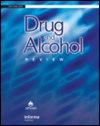Screening and early intervention for substance use during pregnancy: A retrospective case note review of antenatal care records
Abstract
Introduction
Screening for substance use during pregnancy is critical for enhancing maternal health and perinatal outcomes. However, disparities persist in screening and intervention rates within maternity services. This retrospective case note review explored contemporaneous practices around screening and interventions for substance use among pregnant women during routine antenatal care.
Methods
A random sample of 100 sets of maternity records were reviewed. Eligible cases included any woman attending initial pregnancy assessments at one of two South Australian metropolitan Hospital-based antenatal clinics, from July 2019–September 2020. Screening rates for past and current alcohol, tobacco and other substance use were identified and compared with data from a subset of a nationally representative survey. Intervention details and referral pathways were also assessed.
Results
The final sample of eligible cases (n = 93) demonstrated prioritisation of screening for current use, over past use, across all substances (p < 0.001). Screening was most likely for tobacco and least likely for e-cigarettes (p < 0.001). Significant underreporting of past use compared with the benchmark was identified for all substances (except tobacco, p = 0.224). Interventions typically involved written resources, which were usually declined by clients.
Discussion and Conclusions
Despite longstanding recommendations, screening and intervention practices for substance use appear inconsistent. With the recent emergence of vaping, no evidence of updated approaches to identifying e-cigarette consumption in pregnant women was found. Several opportunities for enhancing routine screening and intervention practices within antenatal clinics were identified, and will inform the development of policy directives, targeted training modules, and other resources for health professionals working in these services.

 求助内容:
求助内容: 应助结果提醒方式:
应助结果提醒方式:


